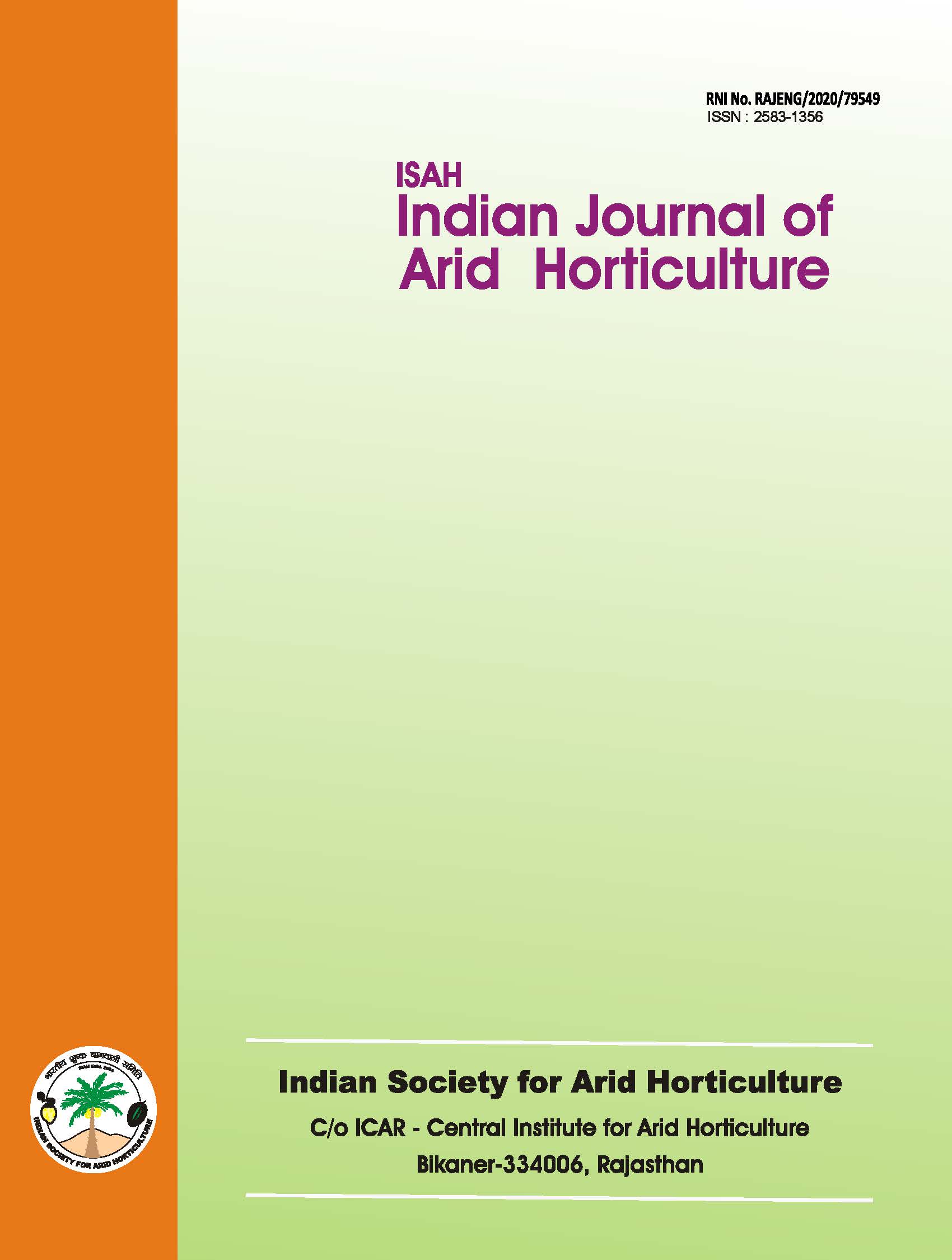Response of irrigation and sulphur levels on yield and economics of radish grown under drip system in arid region of Rajasthan
DOI:
https://doi.org/10.48165/ijah.2024.6.2.8Keywords:
Radish, sulphur, drip irrigation, potential evapotranspiration (PE)Abstract
Studied the effect of various treatments of drip irrigation (60% PE, 80% PE, 100% PE and 120% PE) and sulphur (Control, 15 kg S ha-1, 30 kg S ha-1 and 45 kg S ha-1) on yield and economics of radish. Among the treatments, the drip irrigation at 100% PE was comparable to 120% PE, yielding the highest root fresh weight (213.09 g), root diameter (4.12 cm), root length (30.11 cm), total fresh weight per plant (291.05 g), yield per hectare (313.93 q ha-1), net returns (₹ 112,969 ha-1), and B:C ratio (3.57). Application of 30 kg S ha-1 resulted in maximum root fresh weight (211.75 g), root length (28.94 cm), and root diameter (3.98 cm), as well as the highest total fresh weight per plant (289.87 g), yield (301.57 q ha-1), and net returns (₹ 106,248 ha-1). The treatment combination of 100% PE irrigation with 30 kg S ha-1 resulted in the highest yield per hectare (331.21 q ha-1), though it was statistically comparable to the treatments of 100% PE with 45 kg S ha-1, 120% PE with 30 kg S ha-1, and 120% PE with 45 kg S ha-1. The radish leaves are rich in minerals, vitamin A (5 IU) and vitamin C (15 mg) and roots are rich in potassium (138 mg) Radish (Raphanus sativus L.) is most popular rabi season root crops which cultivated for its important medicinal and nutritive values. It belongs to Cruciferae family. Being a winter season crop, radish is sown in cool season from mid-September to mid-January in northern plains. Radish is the vegetable of both tropical and temperate regions of the world, widely cultivated for its root, tender leaves and green shoots (Alam et al., 2010). It is rich in diverse amino acids and glucosinolate contents (Xie et al., 2018). Glucosinolates are associated with a reduced cancers risks of the lung, pancreas, stomach, prostate, breast, colon and rectum (Herr and Buchler, 2010). The 100 g of edible roots contain 93.7 per cent water, 1.1 per cent fat and 4.2 per cent carbohydrates.Downloads
References
Alam, M. K., Farooque, A. M., Nuruzzaman, M. and Jamai, U.A.F.M. 2010. Effect of sowing time on growth and yield of three radish (Raphanus sativus L.) varieties. Bangla desh Research Publications Journal, 3(3): 998-1006.
Baksh, K. B., Ahmad, Z. and Hassan, S. 2006. Estimating indicators of higher yield in radish cultivation. International Journal of Agriculture and Biology, 8(6): 783-787.
Fisher, R. A. 1950. Statistical Methods for Research Workers. Oli ver and Boyd, Edinburgh.
Herr, I. and Buchler, M. W. 2010. Dietary constituents of broccoli and other cruciferous vegetables: implications for prevention and therapy of cancer. Cancer Treatment Reviews, 36 (5): 377- 383.
and sulphur fertilization. Bangladesh Journal of Agricultural Research, 32 (3): 413-420.
Panse, V. G. and Sukhatme, P. V. 1985. Statistical Methods for Ag ricultural Workers. Indian Council of Agricultural Research Publication. Pp. 87-89.
Saini, K. S. and Brar, N. S. 2018. Crop and water productivity of sugar beet (Beta vulgaris) under different planting methods and irrigation schedules. Agricultural Research, 7: 93–97.
Saxena, C. K., and Gupta, S. K. 2004. Drip irrigation for water conservation and saline/ sodic environments in India: A re view. In: Proceedings of International Conference on Emerg ing Technologies in Agricultural and Food Engineering (etae 2004).
Schonhof, I., Blankenburg, D. Muller, S. and Krumbein, A. (2007). Sulfur and nitrogen supply influence growth, product appear ance, and glucosinolate concentration of broccoli. Journal of Plant Nutrition and Soil Science, 170(1): 65-72.
Solangi, M., Qureshi, N. A, Kandhro, M. N., Leghari, N., Memon, S. A. and Lakho, M. H. 2016. Growth and root yield response of radish (Raphanus sativus L.) to different irrigation regimes. European Academic Research, 4: 4278-4288.
Xie, Y., Xu, L., Wang, Y., Fan, L., Che, Y., Tang, M., Luo, X. and Liu, L. 2018. Comparative proteomic analysis provides insight into a complex regulatory network of taproot formation in radish (Raphanus sativus L.). Horticulture Research, 5(1): 51.
Yadav, L.P., Koley, T.K., Tripathi, A. and Singh, S. 2019. Antioxi dant potentiality and mineral content of summer season leafy greens: Comparison at mature and microgreen stages using chemometric. Agricultural Research, 8: 165-175. https://doi. org/10.1007/s40003-018-0378-7
Yadav, S. B., Adibi Singh, R. P. and Singh, A. 2008. Response of sulphur nutrition on nutritional characteristics of oil and cake of sesame (Sesamum indicum L.) varieties. Journal of Oilseed Research, 25 (1): 38-40.

